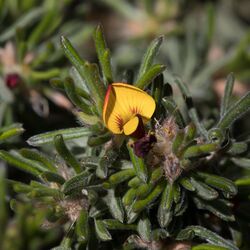Biology:Pultenaea canaliculata
| Coast bush-pea | |
|---|---|

| |
| Pultenaea canaliculata near Mount Compass | |
| Scientific classification | |
| Kingdom: | Plantae |
| Clade: | Tracheophytes |
| Clade: | Angiosperms |
| Clade: | Eudicots |
| Clade: | Rosids |
| Order: | Fabales |
| Family: | Fabaceae |
| Subfamily: | Faboideae |
| Genus: | Pultenaea |
| Species: | P. canaliculata
|
| Binomial name | |
| Pultenaea canaliculata F.Muell.[1]
| |
| Synonyms[1] | |
| |
Pultenaea canaliculata, commonly known as coast bush-pea,[2] is a species of flowering plant in the family Fabaceae and is endemic to coastal areas of southern continental Australia. It is a rigid, spreading shrub with hairy, cylindrical leaves, and yellow and crimson flowers.
Description
Pultenaea canaliculata is a rigid, spreading shrub that typically grows to a height of 1–2 m (3 ft 3 in–6 ft 7 in) with silky-hairy stems. The leaves are needle-shaped, 8–12 mm (0.31–0.47 in) long and 1–1.5 mm (0.039–0.059 in) wide and densely hairy with stipules 2–4 mm (0.079–0.157 in) long at the base. The flowers are borne in clusters near the ends of branchlets surrounded by and often partially hidden by the leaves. There are lance-shaped to awl-shaped bracteoles about 6 mm (0.24 in) long at the base of the sepals. The sepals are about 6 mm (0.24 in) long and densely covered with golden hairs. The standard petal is yellow, 6–7 mm (0.24–0.28 in) long, the wings yellow and the keel is crimson, about the same length as the wings. Flowering occurs from September to November and the fruit is an oval pod surrounded by the remains of the sepals.[2][3]
Taxonomy and naming
Pultenaea canaliculata was first formally described in 1855 by Ferdinand von Mueller in his book Definitions of rare or hitherto undescribed Australian plants from specimens collected "at Encounter Bay".[4][5] The specific epithet (canaliculata) means "channelled".[6]
Distribution and habitat
Coast bush-pea grows on coastal dunes and limestone cliffs from Wilson's Promontory in Victoria, east to the Eyre Peninsula in South Australia, including on Kangaroo Island.[2][3]
References
- ↑ 1.0 1.1 "Pultenaea canaliculata". Australian Plant Census. https://biodiversity.org.au/nsl/services/apc-format/display/58226.
- ↑ 2.0 2.1 2.2 Corrick, Margaret G.. "Pultenaea canaliculata". Royal Botanic Gardens Victoria. https://vicflora.rbg.vic.gov.au/flora/taxon/666c4aac-2153-4628-b97e-7f6392747dda.
- ↑ 3.0 3.1 "Pultenaea canaliculata". State Herbarium of South Australia. http://www.flora.sa.gov.au/cgi-bin/speciesfacts_display.cgi?form=speciesfacts&name=Pultenaea_canaliculata.
- ↑ "Pultenaea canaliculata". APNI. https://id.biodiversity.org.au/instance/apni/461969.
- ↑ von Mueller, Ferdinand (1855). Definitions of rare or hitherto undescribed Australian plants. Melbourne: Goodhugh & Trembath. https://babel.hathitrust.org/cgi/pt?id=hvd.32044106365950&view=1up&seq=46. Retrieved 26 June 2021.
- ↑ Sharr, Francis Aubi; George, Alex (2019). Western Australian Plant Names and Their Meanings (3rd ed.). Kardinya, WA: Four Gables Press. p. 156. ISBN 9780958034180.
Wikidata ☰ Q15525406 entry
 |

